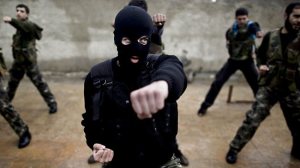The Islamic State of Iraq and Sham (ISIS) accidentally beheaded one of their own commanders recently. Meanwhile, jihadist rebel groups have been fighting against the secular or more moderate Free Syrian Army forces, as well as against Syrian Kurds. Now, a group of Islamic rebel forces has announced a merger: “A statement posted online said Ahrar al-Sham, Jaysh al-Islam, Suqour al-Sham, Liwa al-Tawhid, Liwa al-Haqq, Ansar al-Sham and the Kurdish Islamic Front had agreed to a ‘gradual merger’. It said the new Islamic Front will be an ‘independent political, military and social formation’ to topple the Assad regime and build an Islamic state” (BBC News, Nov. 22, 2013).
Throw into that mix Shia fighters in Assad’s camp, including Hezbollah, Iranian Revolutionary Guard Corps (IRGC), and other pro-Shia Islamist militias, and now we have a full-fledged complex multidimensional sectarian war vying for a dominant Islamism to take hold of Syria.
The announcement of the new Islamic Front “may also challenge the growing influence of the two al-Qaeda-affiliated jihadist rebel groups, the al-Nusra Front and the Islamic State of Iraq and the Levant (ISIS), although they have co-operated with some of its component groups in the past.”
In sum, Syria embodies multi-layered “spiders web-like “ networks of Sunni and Shia militias and paramilitary forces, and this can only continue to plunge Syria into violence and chaos not unlike the Lebanese Civil War (1975-1990), although Syria’s war is at least a hundred times worse and intense and potentially will last a lot longer.
The supporters of these proxy rebel groups, like Saudi Arabia, the UAE, and other GCC states on the Sunni jihadists’ side, and Iran on the Shia side, have no regard for the innocent civilians suffering horrifically in Syria and also as refugees in neighboring countries. These proxy supporters are as guilty of atrocities as Bashar al-Assad. All sides are guilty of war crimes.
More crucially, this merger of jihad franchises in Syria encompasses a “war of Islamisms,” wherein even after Assad’s downfall, these religious rebel groups will continue – and possibly intensify – the war in power struggles, in order for their own Islamist ideology to win. We have seen this pattern of the war of Islamism in Afghanistan and Pakistan. In particular, once the Soviets pulled out of Afghanistan (1989), the multitude of Islamic fundamentalist/militant warlords and militias proliferating throughout the Af-Pak region turned their guns against each other. Within that scenario the Taliban arose and engaged these warlords in the Afghan civil war. We know the rest of the story, once the Taliban succeeded in taking Kabul and creating the “Islamic Emirate of Afghanistan.”
I have called the Syrian civil war the “Afghanistan of the Middle East.” I would love to be proven wrong about that, but this merger of Islamic rebel groups and the power struggles between the Islamic Front and the Al Qaeda-affiliated jihadist groups portend a similar outcome to Afghanistan after the Soviets withdrew. The war of Islamisms is nothing new, especially in terms of the sectarian rivalry between Sunnis and Shias. That’s as old as Islam itself. Now, we see the power struggles in the post-Arab Awakening Middle East and North Africa consist of all shades of Islamists trying to climb over each other for the seats of power. This is all at the expense of civilians, both Sunnis, Shias, Christians, and secularists.
To quote U.S. President John F. Kennedy, “Mankind must put an end to war before war puts an end to mankind.”
Those waging the war of Islamisms seem to fail miserably in grasping that concept.
Hayat Alvi, Ph.D., is an Associate Professor at the US Naval War College.
The views expressed are personal.




